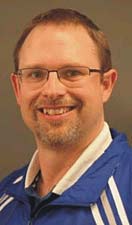|
TennisOne Lessons ½ Court Body Coordination Skills Wayne Elderton In the last few articles we have looked at a way to introduce tennis skills to children 5-7 years old. The concept of ‘skill blocks’ was introduced with the following diagram:
In this article, we will look at Skill Block #3: Body Coordination Skills. The goal of the activities in this group of skills is to use the legs and body (not just the arm) in tennis shots. Inexperienced players view tennis as an "arm game" however, advanced players significantly engage their body when hitting.
Advanced players (even if they are seven years old) have some fundamentals that starter players lack. These become the foundation for more advanced skills. Using the links of the body, from the ground up, in a correct sequence helps both power and control. Untrained players tend to use few links in a poor sequence to play the ball. It takes plenty of practice to efficiently use the body during strokes. Using Rotation on Groundstrokes: One of the ways the human body can make a limb (arm & racquet in tennis) go faster is to let it turn around the core of the body. Although weight transfer is a method that can be used in tennis, rotation is critical to maximize efficiency. Rotating the body with coordination is the mark of an advanced player. Helping children to experience and control their body rotation is a fundamental required for their future success. Power Advantage: Using the body in a coordinated way means that racquet speed can be generated with less effort. No segments of the body are over-used which means less injury and more economy (no wasting energy which makes a player tired faster). Control Advantage: If power is being generated efficiently, players feel more at ease. Since they don’t have to ‘try to hit hard’, and the motion is not wild, they can more easily feel and control the racquet path and angle. In other words, they experience what all top players know, generating power fluidly helps control. Only less advanced players make an either/or choice (either power or control). The key for success in tennis is to balance both.
Rotation on the Set-up: To be able to experience all these advantages of rotation, the players must first set-up for the shot in a way that allows their body to turn. Preparing with the body and racquet together is called a ‘unit turn’. This type of preparation sets the body up to be used efficiently during the stroke. Developing these fundamentals takes time and practice. The activities of Block #3: Body Coordination Skills are specifically designed to introduce these fundamentals in simplified ways. We will look at a couple of useful exercises players can do to develop good body coordination on groundstrokes. Medicine Ball: This is a great exercise for developing groundstroke actions. For 5-7 year olds, a light 2 pound (1 kg) ball should be used. It is also acceptable to use a basketball, soccer ball, or oversized display tennis ball (like the kind players autograph at tournaments). The advantage of a medicine ball is that it is a little heavier. The weight forces the player to engage more segments (use their body more). Players use a ‘stroke action’ (like a 2-handed BH) to send the ball to each other. They must feel how they engage the whole body, rotating from the ground up. It is important to also help players maintain a good, ‘line of gravity’. Staying balanced provides a good axis to rotate around. Tipping or bending at the waist throws the rotation off.
This can easily turn into a game where they throw the ball over the net to each other (simulating a rally). The ‘prescription’ for this exercise is to throw the medicine ball 8 times, then rally 8 shots. The key is to have players maintain the same ‘medicine ball feeling’ when hitting with the racquet. This 8 throws/8 hits sequence is repeated 3-4 times on both FH and BH sides. Tube Twists: Another tool for players to feel rotation is a ball pick-up tube. Players hold the tube against their back and rotate (see video). The tube becomes a reference. It shows the axis of their hips and shoulders. For example, they can see how much rotation is needed to prepare sideways by turning until the ends of the tube point to the net and back wall. If they turn forward for a forehand, they can feel how much rotation is needed (turn until the tube ends are pointed to the side walls). For a one handed backhand, the player would develop the feel of not rotating so much (e.g. “Keep the tube pointed to the net to stay sideways). These exercises helps develop sensitivity to rotating (or minimizing rotation). Players see how their body must be used on groundstrokes.
Using the Drills as Tools This was also mentioned in the last article but it bears repeating. These drills are not just a progression of activities but are also great for specific ‘remedial’ work. For example, if players were rallying, and the coach saw players hitting with their arm only, it may be too difficult to get players to change while rallying. The solution is to use these drills to delve deep into the technical details. Once players got a feel for the technique, the coach would let them rally again with the emphasis on the newly acquired technical skill. This process is called the ‘Accordion’ method (introduced in previous articles in this series). Developing 5-7 years olds in a Progressive Tennis format is recommended by the International Tennis Federation (ITF). Their world-wide Play & Stay initiative (and the USTA Quick Start Initiative in the US) will help more players get better faster. Your comments are welcome. Let us know what you think about Wayne Elderton's article by emailing us here at TennisOne.
|


 Wayne Elderton
Wayne Elderton